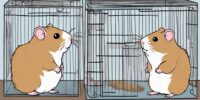Do Parrots From Different Regions Show Distinct Behavioral Patterns?
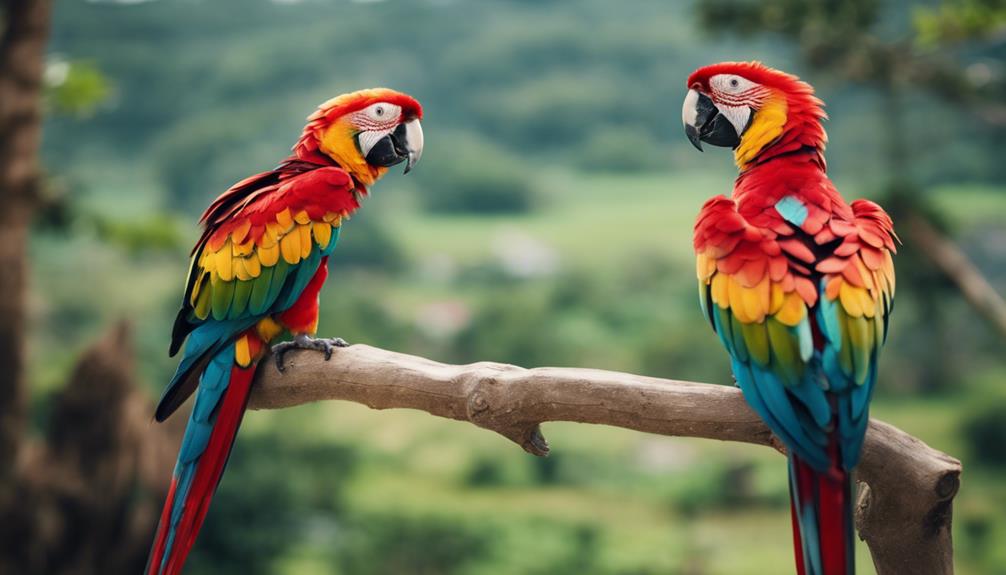
These patterns can include variations in vocalizations, feeding habits, and social interactions.
For example, parrots from tropical rainforest regions may exhibit more complex vocalizations and be more social, while those from arid regions may be more independent and have different feeding strategies.
Overview of Parrot Behavior Studies
Research on parrot behavior has provided valuable insights into the complex and varied ways these avian creatures interact with their environment. Social interactions among parrots play a crucial role in their daily lives, influencing their behavior and overall well-being. By studying these interactions, researchers have been able to observe how parrots communicate through vocalizations, body language, and other cues. Understanding the dynamics of their social groups has shed light on the hierarchical structures and relationships within parrot communities.
Moreover, feeding habits and mating rituals are significant aspects of parrot behavior that have been extensively studied. Parrots exhibit diverse feeding behaviors depending on their species and environment, ranging from foraging for nuts and fruits to hunting for insects. Mating rituals in parrots are intricate and often involve elaborate displays of plumage, vocalizations, and courtship dances. These behaviors are crucial for the survival and reproduction of parrot populations, making them essential subjects of scientific inquiry.
Factors Influencing Parrot Behavior

Parrot behavior is significantly influenced by regional variations and environmental factors, shaping their distinct behavioral patterns.
Understanding how different regions and environments impact parrot behavior is crucial in comprehending the complexities of their actions.
These factors play a pivotal role in determining the behavioral repertoire exhibited by various parrot species.
Regional Behavior Variations
Regional variations in behavior among parrots can be influenced by a variety of factors, including environmental conditions, social interactions, and genetic predispositions. Parrots from different regions may exhibit unique behaviors in vocal communication and feeding habits, shaped by their surroundings and interactions with other parrots. Below is a table highlighting some common regional behavior variations observed in parrots:
| Behavior Aspect | Regional Variation |
|---|---|
| Vocal Communication | Australian parrots are known for their complex vocalizations, while African Grey parrots are skilled mimics. |
| Feeding Habits | South American parrots often have specialized beaks for cracking nuts, while Southeast Asian parrots have diverse diets including fruits, seeds, and insects. |
Environmental Influence on Behavior
Environmental conditions play a crucial role in shaping the behavioral patterns of parrots, influencing aspects such as foraging strategies, social interactions, and vocalizations. Regional influences, such as climate, habitat availability, and predator presence, can significantly impact parrot behavior.
For instance, parrots in tropical regions may exhibit different foraging behaviors compared to those in arid environments, adapting to the varying food sources and environmental challenges. Behavioral diversity among parrot populations can also be influenced by factors like human presence, deforestation, and pollution levels.
Understanding how environmental factors shape parrot behavior is essential for conservation efforts and ensuring the well-being of these intelligent birds in their natural habitats. By studying these influences, researchers can better comprehend the adaptive strategies parrots employ to thrive in diverse ecosystems.
Case Studies on Regional Parrot Behaviors
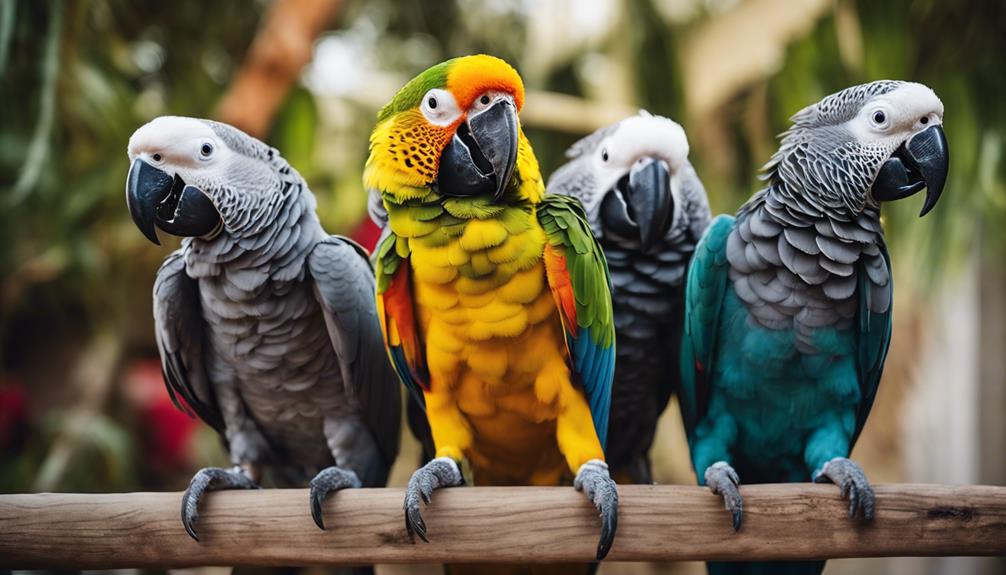
In various parts of the world, researchers have observed distinct behavioral patterns among different species of parrots that inhabit specific regions. These behaviors can vary significantly in terms of vocal communication and feeding habits. Here are some intriguing case studies showcasing regional parrot behaviors:
| Region | Vocal Communication Behavior | Feeding Habit Behavior |
|---|---|---|
| Amazon Rainforest | Parrots exhibit complex vocalizations, mimicking a diverse range of sounds from their environment. | Parrots show a preference for fruits, seeds, and nuts, displaying specialized foraging techniques. |
| Australian Outback | Parrots engage in loud, screeching calls as a form of long-distance communication with their flock members. | Parrots demonstrate a unique feeding behavior known as seed husking, where they meticulously extract seeds from their shells. |
| African Savanna | Parrots in this region have limited vocalizations, relying more on body language and simple calls for communication. | Parrots display adaptive feeding habits, consuming a variety of foods depending on seasonal availability. |
These case studies highlight the fascinating diversity of regional parrot behaviors, shedding light on the intricate ways these intelligent birds adapt to their environments.
Comparative Analysis of Parrot Behaviors
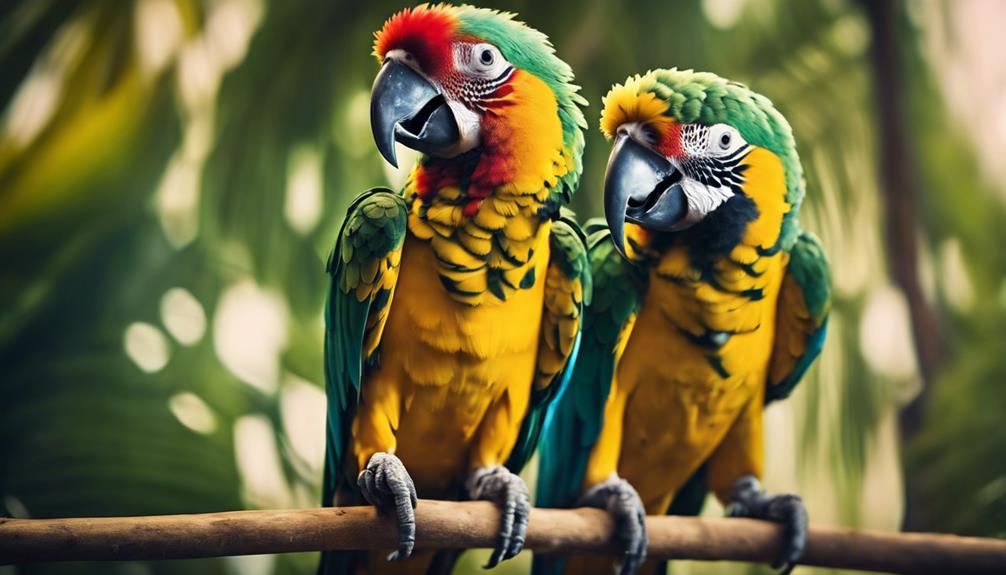
A comparative analysis of parrot behaviors reveals distinct variations in vocal communication and feeding habits across different species and geographical regions. When studying parrot behaviors, researchers have observed the following key points:
- Vocal Communication: Parrots exhibit diverse vocalizations that vary not only between species but also within the same species based on their geographic location. For example, African Grey Parrots in the wild may have distinct calls compared to those in captivity due to environmental influences.
- Social Interactions: The social dynamics among parrots differ significantly based on their natural habitats. Some species are more communal, engaging in flock behaviors and cooperative feeding, while others may be more solitary or form smaller family units.
- Feeding Habits: Parrots display a range of feeding habits influenced by factors such as food availability and competition within their habitat. This can lead to variations in foraging techniques and diet preferences among different parrot populations.
Understanding these behavioral differences is essential for conservation efforts and providing optimal care for parrots in captivity or the wild.
Environmental Impact on Parrot Behavior
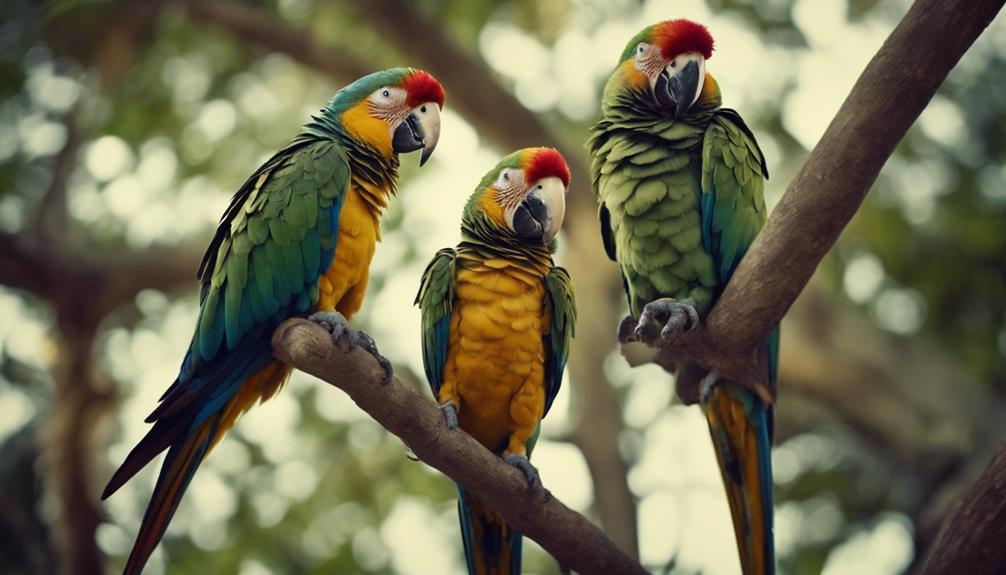
Regional climate effects, habitat diversity influence, and adaptation to surroundings are key factors that shape the behavior of parrots. Understanding how different environmental conditions impact their behavior can provide valuable insights into their cognitive and social dynamics.
Regional Climate Effects
Climate variations significantly influence the behavioral patterns exhibited by parrots in different habitats. When discussing the impact of regional climates on parrot behavior, several key factors come into play:
- Dietary Adaptations: Parrots in regions with limited food sources may exhibit foraging behaviors distinct from those in more abundant environments.
- Social Interactions: Regional tendencies influenced by climate can affect flock dynamics, communication, and mating rituals among parrots.
- Nesting Habits: Climate adaptation can influence the selection of nesting sites, materials used for nest building, and breeding seasons in different parrot populations.
Understanding how parrots adapt to their specific regional climates is crucial in comprehending the behavioral nuances observed within diverse parrot populations.
Habitat Diversity Influence
The diverse habitats where parrots reside play a significant role in shaping their behavioral patterns. Parrots exhibit distinct behaviors based on their habitat preferences and the social interactions within those environments. Different habitats provide varying levels of resources, such as food availability, nesting sites, and protection from predators, influencing the social dynamics and behaviors of parrot populations. Below is a table illustrating how habitat diversity can impact parrot behavior:
| Habitat Type | Behavioral Impact |
|---|---|
| Tropical Forests | Enhanced social interactions due to flocking behavior |
| Grasslands | Increased territorial aggression |
| Coastal Regions | Preference for communal roosting sites |
| Mountainous Areas | Solitary behavior patterns |
| Wetlands | High levels of cooperative breeding |
Adaptation to Surroundings
Parrots adapt their behavioral patterns to suit their surroundings, responding to environmental cues that shape their interactions and social dynamics. Regional variations and natural selection play crucial roles in determining these adaptations.
Some adaptation strategies observed in parrots include:
- Foraging Techniques: Parrots in regions with limited food sources may develop specialized foraging techniques to efficiently locate and consume food.
- Social Structure: Regional variations can lead to differences in social structures among parrot populations, impacting mating systems and group dynamics.
- Communication Patterns: Environmental factors influence communication strategies in parrots, leading to variations in vocalizations and body language used for social interactions.
These behavioral differences highlight the remarkable ability of parrots to adapt to diverse environments through evolutionary processes like natural selection.
Behavioral Adaptations in Parrot Species
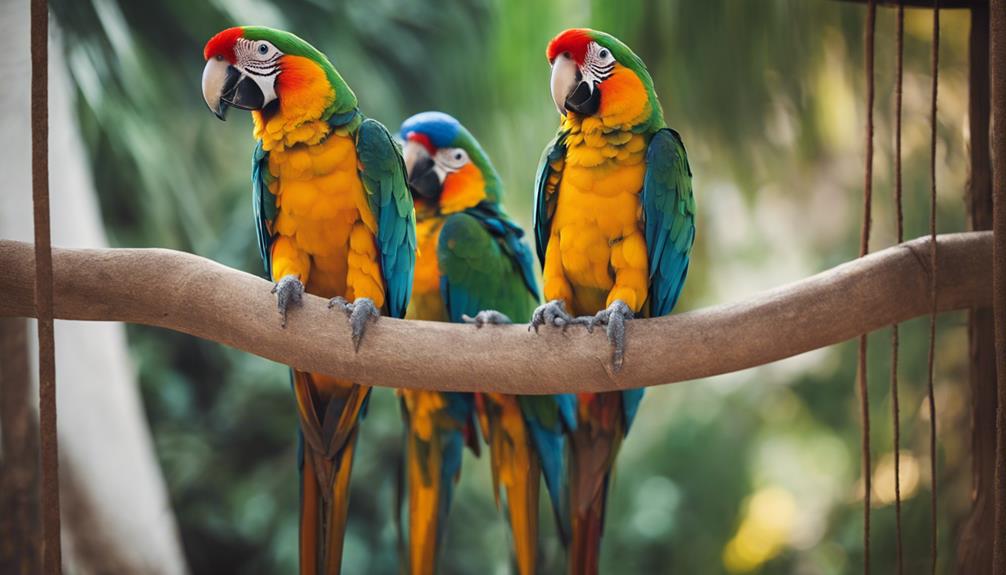
Behavioral adaptations in various species of parrots exhibit remarkable diversity in response to environmental stimuli. These adaptations play a crucial role in the survival and reproduction of parrot species across different regions. Some key behavioral adaptations include social interactions, communication, foraging strategies, and vocalizations.
| Behavioral Adaptations | Description | Example |
|---|---|---|
| Social Interactions | Parrots engage in complex social structures | Flocking behavior in Amazon parrots |
| Communication | Vocalizations are used for various purposes | Mimicking sounds in African Grey parrots |
| Foraging Strategies | Different species show unique feeding habits | Tool usage in New Caledonian crows |
| Vocalizations | Calls and sounds are essential for survival | Alarm calls in Monk parakeets |
| Nesting Behaviors | Nest building and parenting techniques | Burrowing nests in Burrowing parrots |
These adaptations showcase the diverse ways parrot species have evolved to thrive in their specific habitats. Understanding these behaviors is essential for conservation efforts and ensuring the well-being of these intelligent birds.
Implications for Conservation Efforts
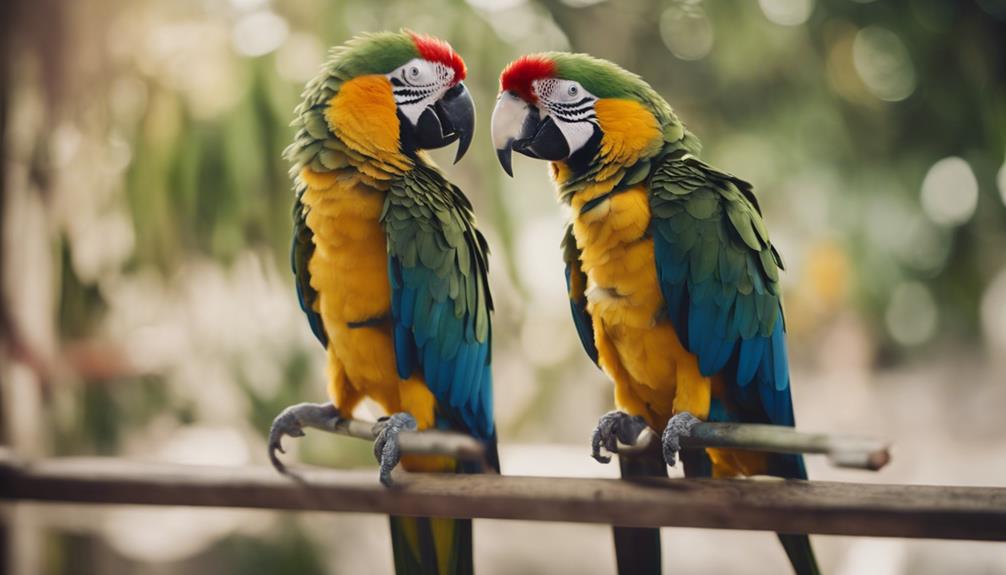
With a focus on preserving biodiversity, conservation efforts in parrot species necessitate a comprehensive understanding of their distinct behavioral patterns. Geographic differences in behavior among parrot populations can have significant implications for conservation strategies:
- Tailored Conservation Programs: By recognizing behavioral variations across different regions, conservationists can design targeted plans that address specific needs of parrot populations. For instance, understanding the unique foraging behaviors of parrots in a particular region can help in the implementation of habitat restoration projects that promote food availability.
- Effective Monitoring and Management: Knowledge of behavioral patterns can aid in developing efficient monitoring protocols to assess population health and trends accurately. Conservation efforts can be more effective when tailored to the behaviors exhibited by parrots in different geographic areas.
- Mitigating Human-Wildlife Conflict: Understanding how parrot behavior varies across regions can assist in developing strategies to reduce conflicts with humans. By identifying behaviors that may lead to conflicts, conservationists can implement measures to mitigate these issues and promote coexistence between parrots and human communities.
Frequently Asked Questions
How Do Parrots Communicate With Each Other in the Wild?
In the wild, parrots communicate through intricate vocal mimicry, displaying complex hierarchy dynamics. They use their calls to establish territories, attract mates, and coordinate feeding strategies. This vocal repertoire plays a crucial role in mate selection and social cohesion.
What Are Some Common Threats to Parrot Populations in Different Regions?
Common threats to parrot populations in different regions include habitat loss, climate change, and poaching. Conservation strategies are crucial to mitigate these challenges and safeguard parrot species from further decline in the wild.
Do Parrots in Captivity Exhibit Different Behavioral Patterns Compared to Those in the Wild?
In captivity, parrots often display altered behaviors due to socialization differences. Their behavioral adaptations to human interaction can vary significantly from those in the wild. Understanding these distinctions is crucial for their well-being and successful care.
Are There Any Specific Cultural Practices That Impact Parrot Behavior in Certain Regions?
Regional influences and cultural practices can significantly impact parrot behavior in specific areas. Understanding these factors is crucial to comprehending the full range of behaviors exhibited by parrots across different regions and environments.
How Do Parrots' Social Structures Differ Between Different Species and Regions?
Parrots' social structures vary based on species and regions. They establish social hierarchies through displays of dominance and submission. Mating rituals involve intricate dances and vocalizations to attract partners. These behaviors are crucial for reproductive success.






